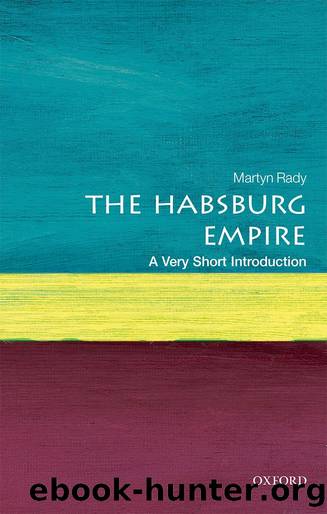The Habsburg Empire by Martyn Rady

Author:Martyn Rady [Rady, Martyn]
Language: eng
Format: epub
ISBN: 9780192511355
Publisher: OUP Oxford
Published: 2017-01-10T00:00:00+00:00
Chapter 5
Enlightenment and reaction: 18th and 19th centuries
âTreasury scienceâ and natural law
From the late 17th century onwards, visitors went from Habsburg Central Europe to France, England, and the Netherlands. They saw the ships, manufactures, populous cities, and energetic political discussion, all of which were missing back home. Central Europeans felt that they were backward. As one of the earliest of these self-critical observers remarked, âWe are forever only giving foreigners occasion for hearty laughter. They are laughing at us and they are right.â Or, as Philip von Hörnigk wrote in his Austria Over All (if she only wants to) (1684), âNothing is sound with us, from head to foot ⦠Things are in such a condition that it is something like an Austrian miracle that everything has not yet gone to total ruin long ago.â
Hörnigk belonged to the group of economists known as âcameralistsâ or practitioners of âtreasury scienceâ. This was the study of how states and institutions might maximize revenues in the absence of foreign sources of enrichment and thus overcome their backwardness. Cameralists assumed that it was the purpose of the state to marshal its resources both for its own defence and for the benefit of its citizens, as a way of enlarging their wealth and happiness. The measure of this intervention differed from author to author. Some believed that it was enough to create the conditions for happiness, for it was the individualâs right to determine how he reacted with the external world. Most, however, assumed that individuals could not be trusted to secure an order of maximum perfection and that a benevolent government should intervene and direct, even at the expense of individual liberty. Accordingly, cameralists frequently advocated what amounted to a âprogramme of total regulationâ. Within this scheme, individual rights took second place to the interests of the larger societyâhence, because a burgeoning population was conceived to be good thing, abortion should be clamped down on, cripples removed from public places lest they shock women into miscarriages, and so on. The âwell-orderedâ state for which the cameralists worked was sometimes called the Polizei-Staat, which means âregulated stateâ.
Cameralism complemented the new philosophy of natural law, which by the 18th century dominated the universities and educated discussion. Natural law theory rested on two principles. The first was that society and sociability were implicit in the human condition. The second was that government existed for the benefit of societyâkings did not rule because God had appointed them; their dominion was for a purpose that was located in the society of their subjects. Natural law theory gave a moral underpinning to cameralism, converting its dry economics and regulatory regime into a set of philosophical imperatives.
At its worst, cameralism and natural law could lead to a dull utilitarianism which sought to banish literature, philosophy, and astronomy from the university curriculum on the grounds that they were not âusefulâ. At the other extreme, they threatened social revolution. The rights of the nobility, of their antique diets, and of the Church rested on tradition and they could hardly be justified in terms of their social benefit.
Download
This site does not store any files on its server. We only index and link to content provided by other sites. Please contact the content providers to delete copyright contents if any and email us, we'll remove relevant links or contents immediately.
| Africa | Americas |
| Arctic & Antarctica | Asia |
| Australia & Oceania | Europe |
| Middle East | Russia |
| United States | World |
| Ancient Civilizations | Military |
| Historical Study & Educational Resources |
Magic and Divination in Early Islam by Emilie Savage-Smith;(1500)
Ambition and Desire: The Dangerous Life of Josephine Bonaparte by Kate Williams(1344)
Bohemians, Bootleggers, Flappers, and Swells: The Best of Early Vanity Fair by Bohemians Bootleggers Flappers & Swells- The Best of Early Vanity Fair (epub)(1343)
Papillon by Henry Charrière(1310)
Twelve Caesars by Mary Beard(1256)
Operation Vengeance: The Astonishing Aerial Ambush That Changed World War II by Dan Hampton(1136)
What Really Happened: The Death of Hitler by Robert J. Hutchinson(1129)
London in the Twentieth Century by Jerry White(1114)
Time of the Magicians by Wolfram Eilenberger(1089)
The Japanese by Christopher Harding(1086)
Twilight of the Gods by Ian W. Toll(1084)
Lenin: A Biography by Robert Service(1045)
The Devil You Know by Charles M. Blow(985)
A Social History of the Media by Peter Burke & Peter Burke(936)
Freemasons for Dummies by Hodapp Christopher;(922)
Napolean Hill Collection by Napoleon Hill(902)
Henry III by David Carpenter;(891)
The Churchill Complex by Ian Buruma(882)
The Rise and Triumph of the Modern Self by Unknown(879)
